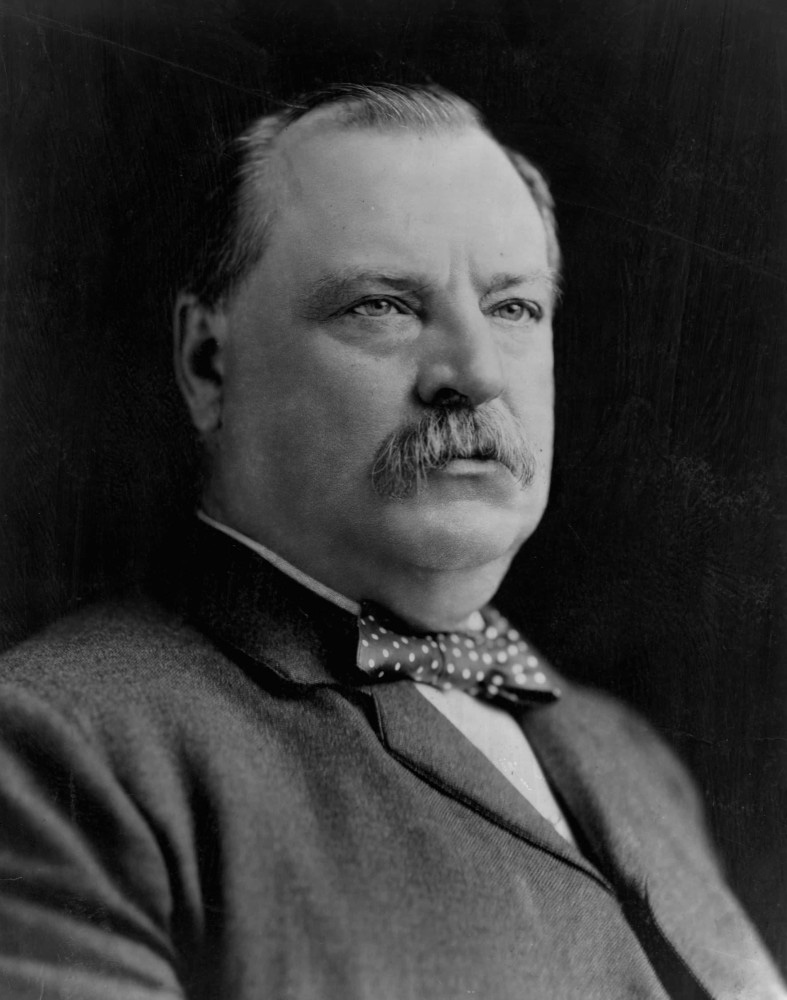Until this past election, Grover Cleveland (D-NY) was the only president to serve two non-consecutive presidential terms. President-elect Donald Trump (R-FL) recently met with President Joe Biden (D-DE) to formally take the keys back to the White House, becoming the first president since 1892 to win a second non-consecutive term and the first Republican ever to do so.
This week, we’ll look at the history of both campaigns and how both men were catapulted back into Washington after a four year absence.

Grover Cleveland – 1885-1889, 1893-1897
Cleveland came from modest upbringings. Born in Caldwell, New Jersey, in 1837, he would leave school in 1853 after his father’s death and later clerked at a law firm in Buffalo before being admitted to the New York bar in 1859. After serving as an assistant district attorney in Erie County, his first elected position would come in the form of Erie County Sheriff from 1871 to 1873, followed by a short term as Mayor of Buffalo during most of 1882. His reputation earned him the nickname of the “veto mayor,” as he was a fiscal stalwart and worked against “waste, fraud, and abuse” before the phrase was “coined” into a sound bite by Trump.
His mayoralty would thrust him into the national spotlight, winning the New York governor’s race in 1882. The election was a landslide for Cleveland, who took all but eight of New York’s sixty-two counties, winning with 58% of the vote.
Cleveland would serve just one term as governor before successfully winning the presidency in 1884.
Cleveland narrowly defeated Congressman James G. Blaine (R-ME) by just 0.5% in the popular vote and 219 electoral votes. At the time, just 201 were needed for victory, as twelve current states had not yet been formed.
Despite his popularity in New York, Cleveland only narrowly won his home state by a razor-thin margin – just 0.10% – but his narrow edge allowed him to flip the White House from Republican control, with then-President Chester A. Arthur (R-NY) unsuccessful in receiving the nomination for a full term. Arthur had never been elected president in his own right, but had ascended to the White House following the assassination of James Garfield (R-OH).
Cleveland’s tough, anti-corruption stances hurt him with perhaps the machine he most needed behind him: Tammany Hall. Then the cornerstone of politics in New York City, Tammany Hall has become synonymous with corruption and machine-like politics. Its foul reputation towards the end of the 1800s virtually guaranteed Cleveland a complicated path to the White House, so long as Cleveland wasn’t willing to play ball.
Cleveland was the first Democrat to win the presidency since James Buchanan (D-PA) in 1856 and was the first Democrat to be president since Andrew Johnson (D-TN) left office in 1869. Following his victory in 1892, no other Democrat would win the presidency until Woodrow Wilson (D-NJ) in 1912. For this reason, 1884 is seen as a landmark election that interrupted decades of Republican control of the presidency between Reconstruction and the Great Depression.
But Cleveland, like Trump, staged his own comeback, then considered unthinkable based on the circumstances.
As president, Cleveland continued his anti-corruption and anti-wasteful spending scourge, especially during the Gilded Age, a time of rapid wealth increase, industrialization, and rampant corruption. One hallmark of Cleveland’s penny-counting agenda was his veto against private pension bills to Civil War Veterans who fraudulently claimed service during the war. Cleveland took his “veto mayor” pin to Washington, vetoing more bills than all prior presidents combined.
In 1888, however, Cleveland would narrowly lose the election to Benjamin Harrison (R-IN), taking 168 electoral votes to Harrison’s 233, again, with 201 needed to win. Of note, the 1888 election is one of just five instances in which the winner of the popular vote did not win the presidency. Cleveland won the popular vote by almost a full percentage point over Harrison.
Like this election cycle, tariff policy was one of the key issues. Cleveland had taken the position of reducing high tariffs that he argued were unfair to consumers, while Harrison sided with industrialists and factory workers who wanted tariffs to remain in place. His opposition to the aforementioned Civil War pensions, along with inflation, made him a pariah among Veterans and farmers, but kept him viewed favorably for his reformist stance in an era that was badly in need of reform.
Cleveland’s 1888 loss marks the first and only time in which an incumbent president of any party lost a re-election bid despite winning the popular vote. Harrison narrowly flipped New York (and Suffolk County) that year, as well as his home state of Indiana.
Like Trump, Cleveland faced his own onslaught of personal attacks. One allegation is that Cleveland fathered a child out of wedlock while still a bachelor, and another was of his marriage to Frances Folsom, a woman twenty-seven years his junior. To date, Cleveland is the only president to have been married while in the White House.
Cleveland would muster an unthinkable comeback in 1892, defeating Harrison with 277 electoral votes – this time 223 were needed to win, as six states were added to the Union since the last election – and by three points in the popular vote. Cleveland flipped back New York, winning this time by three-and-a-half points, as well as California, Illinois, Indiana, and Wisconsin. Further complicating the 1892 elections was Populist James B. Weaver of Iowa, who won five states, twenty-two electoral votes, and 8.6% of the popular vote. North Dakota participated in its first election, going for Weaver in the raw count, but had chosen its electors individually, rather than a slate. As a result, Cleveland took one vote from the Peace Garden State. This remains the last time that a state awarded non-faithless electoral votes to more than two candidates.
Interestingly, California is just one of three states that Cleveland won in his third campaign but lost in his prior two. Trump only has one state that fits a similar column: California’s next-door neighbor, Nevada.
Cleveland campaigned hard on fiscal measures, remaining a proponent of the gold standard, while Populists were interested in bimetallism, which would have included silver in the country’s currency metrics, purposefully inflating the currency to help farmers pay off their debts due to over-farming of the land after the Homestead boom.
His second term of the presidency marked the end cap of his career. Cleveland declined to run a fourth time in 1896, which saw the open seat handily won by William McKinley (R-OH).
Cleveland died on June 24, 1908, in Princeton, New Jersey, at the age of 71.

Donald Trump – 2017-2021, 2025-2029
Marking a significant political comeback, Donald Trump joins the ranks of Grover Cleveland in a spot that has been squared off by history for the last 130 years.
Trump, like Cleveland, ran as a reformist in a time when such a platform was deemed necessary by the public. Trump’s promises to stem “waste, fraud, and abuse,” and to “drain the swamp” of government in Washington resonated with voters in 2016.
He left Washington in 2021, surrounded by few apart from his family, with no political future seemingly in store for him. In his off years, Trump would face legal challenges from New York, alleging campaign finance violations, as well as scrutiny and possible legal ramifications for his role in the January 6, 2021, storming of the U.S. Capitol. Trump’s personal life was also expected to have kneecapped his electability, while Democrats defied the historic curse of the incumbent party facing massive losses during their president’s first midterm year. This had caused many on both sides to believe the Trump Era was, in part, over, and that a majority of Americans had viewed him, his policies, and his surrogates as unelectable.
But Trump’s comeback was astonishing as it was decisive. While not a landslide, he becomes the first Republican since 2004 to win the popular vote, the first since 2004 to win Nevada, and at 78 years old, is the oldest person to have ever been elected president.
Meanwhile, J.D. Vance (R-OH), 40, is set to be the third-youngest vice president in history, and the first millennial ever to be elected to the position.
Trump is also the eighth presidential nominee to win non-faithless electors in at least three elections, and he and Richard Nixon (R-CA) are the only presidential candidates to win a significant number of electoral votes in three elections since term limits were enacted in 1957. Across his three elections, Trump has amassed 850 electoral votes.
Are Non-Consecutive Terms the New Norm?
We would say that this is not the new norm, but clearly, anything is possible in this day and age. We liken the comeback to a similar political time when Grover Cleveland was able to perform the same feat. It’s possible that divisions could continue, allowing non-consecutive terms to become more common than they once were, but as periods of history are cyclical, we assume this is one facet of our republic that will turn back to the norm once the dust settles.
In any case, it is a remarkable streak of history that has been broken and one that many had likely not thought they be alive to see.




